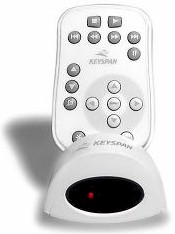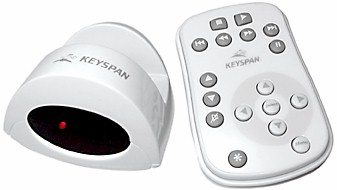The Pitch & Product

| Keyspan Express Remote | |
|---|---|
| Summary | Compact IR control for remote iTunes control via AirPort Express. Can also be used for general Mac OS / Windows computer control |
| Update | None |
| Pros | • Flexible • Easy to use • Easy to extend |
| Cons | • No display limits iTunes navigation • You pay a premium for AirPort Express / iTunes features |
I added an AirPort Express express to my home network a while back and found it to be an interesting little device. It’s a bit hard to put a label on, but I like to think of it as the “swiss-army knife” of network appliances. In addition to being an interface between iTunes and a stereo, it can act as a wireless router/base station, print server, or wireless range-extender. And it does this all in a stylish little white box slightly larger than the power-adapter for my iBook.
On my LAN, I’ve been mostly using the AirPort Express for sending the output of iTunes into my stereo. It does a good job of this, but like many other people, I wished there were a way to remotely control it when playing music. Apple doesn’t sell a remote for the box, but when there’s a market for a device, there’ll be someone out there to satisfy the need.
In this review, I’ll take a look at the Express Remote from Keyspan. Much like the AirPort Express itself, this remote doesn’t stop with a single function – it has multiple personalities too.

Figure 1: Remote and Receiver
The Express Remote comes in three pieces, a credit-card sized 17 button remote powered by two button batteries, an IR receiver that has a handy slot to hold the remote when it’s not in use, and a standard USB cable. The product works with Macintosh Os X 10.3 or higher, or Windows XP or 2000.
Like the AirPort Express, the Remote takes a bit of thought to hook it up. First question is whether the USB cable plugs into your computer or into the AirPort Express? The answer is either. You plug the receiver into the USB port of the AirPort Express if you only want to use it as a remote for iTunes.
But you plug it into your computer if you want to use it as a general purpose computer remote control, or if the USB port on the AirPort Express is being used for a printer. You’ll pay a bit of a premium for this flexibility, however. The Express Remote retails for around $60, while a similar remote from Keyspan that only plugs into your computer goes for around $50.
The Test & Verdict
The Remote feels a bit small in the hand, but it’s usable, and a small remote has benefits for portability. Buttons are provided for the basics such as play, pause, stop, previous track, next track, etc. as well as volume control and shuffle play. But note that when controlling iTunes, several keys are unused. I had no trouble with the range of the remote and it easily covered my living room from the locations where I needed it.
Note also that the Remote does not have a display of any sort. So when you’re using it to control a remote iTunes server, you’ll essentially be “flying blind”. Although this felt a bit awkward after being accustomed to seeing track information through iTunes, that’s the nature of this device.
Like most people, I opened up the box, disregarded all included paperwork and software and proceeded to plug the receiver into my AirPort Express. Next, I started up iTunes on my iBook since the basic idea is that the remote will send commands from the AirPort Express back to the computer to control iTunes.
After firing up my stereo, I started clicking buttons on the little remote. No joy, no music. The receiver was unresponsive, silently blinking a red light at me. So, back I went to the paperwork included in the package. After a little bit of reading and poking around on my system, I found that I needed a firmware update for my AirPort Express in order to use the remote. A quick Google search found the download site for Apple’s AirPort Express Firmware Update 6.1. After an easy AirPort Express firmware upgrade process, I tried again. Success! The remote was now controlling iTunes.
The little remote controls iTunes just fine, but it has more tricks up its sleeve. It’s also designed to provide generic remote-control to your computer. If you want to use it this way, you reverse the hookup – plugging the receiver into the computer instead of the AirPort Express.
This mode requires a driver installation from the included CD which basically makes the remote act as a keyboard input device. For example, the arrow keys on the remote could map to next and previous slide in PowerPoint. Key mappings are provided for a number of standard applications such as iTunes, Real Player, DVD player, a CD Player, PowerPoint, as well as global keys such as volume control.
If the mappings between the remote keys and the keyboard actions are not to your liking, an editor is provided for making changes or adding additional bindings. And if a simple keystroke is not enough, the editor also has a setting to allow a remote key to map to a custom script. Using the device in this mode is useful for applications such as DVD playing where you may not want to be sitting at the computer but still want to have control.
While not revolutionary, the Express Remote is a useful little device. If you have a college student on your holiday gift list, it would be perfect for cramped dorm rooms where a computer plays double-duty as a DVD player and stereo. If your gift list includes someone who often gives presentations, the Remote would make single-handed slide-control a breeze. Or, if you want to make sure you get a nifty little device this holiday season, wrap one up for yourself!
